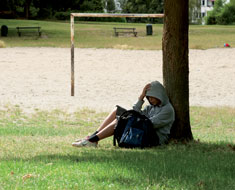In 2008, 17% of the population in the EU 27, just over 84 million persons, were at risk of poverty. This means that their income was below the poverty threshold.
The highest at-risk-of-poverty rates in 2008 were found in Latvia (26%), Romania (23%), Bulgaria (21%), Greece, Spain and Lithuania (all 20%), and the lowest in the Czech Republic (9%), the Netherlands and Slovakia (both 11%), Denmark, Hungary, Austria, Slovenia and Sweden (all 12%).
Children (19%) and elderly people (20%) are more at risk of poverty than the total population.
In order to get a more precise picture of poverty in the EU, the material deprivation rate describes poverty in more absolute terms.
17% of the population of EU27 were lacking at least three of nine basic items (like capacity to heat properly one's home, to have a meal with meat or equivalent every two days, to possess a washing machine … etc).
The highest levels were registered in Bulgaria (51%), Romania (50%), Hungary (37%) and Latvia (35%), and the lowest in Luxembourg (4%), the Netherlands and Sweden (both 5%).
These figures are issued by Eurostat, the Statistical Office of the European Union.
"Combating poverty and social exclusion: a statistical portrait of the European Union 2010"  presents a broad range of statistical concepts and indicators from social statistics across the 27 Member States, as well as providing information about candidate and EFTA countries.
presents a broad range of statistical concepts and indicators from social statistics across the 27 Member States, as well as providing information about candidate and EFTA countries.










